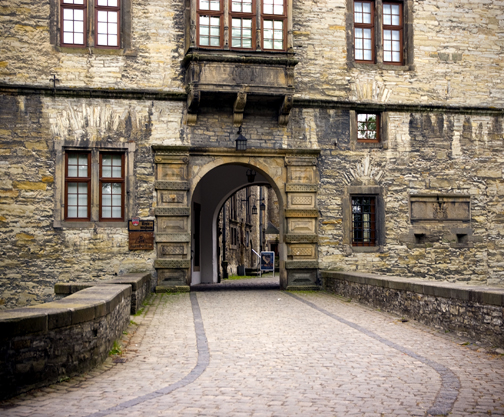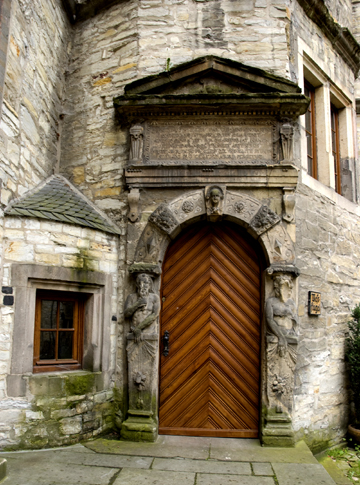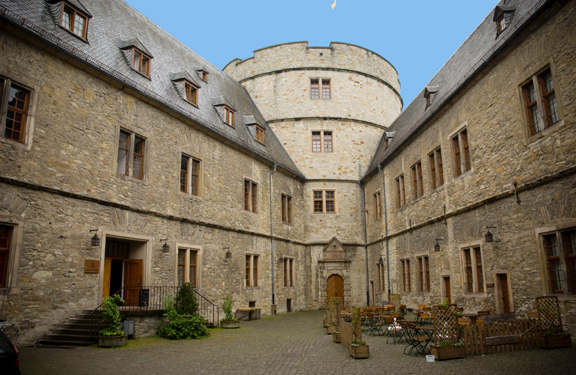Wewelsburg Castle  The Renaissance castle pictured above is located within the village of Wewelsburg, which is part of the city of Büren, in the district of Paderborn in North-Rhine Westphalia, Germany. Standing high on a rock overlooking the Alme valley, the castle is currently a Youth Hostel and a Museum for the District of Paderborn. The Paderborn airport is only 6 or 7 miles from the castle. The Wewelsburg castle was built between 1603 and 1609, on the site of a previous castle, as a second residence for the Prince Bishops of Paderborn. It features three towers connected by walls which enclose a triangular shaped courtyard. Wewelsburg is the only three-sided castle in Germany. The West tower, shown in the photo at the top of this page, is the location of the dungeon where witches were imprisoned and tortured during the 17th century. In 1938, during the pogrom known as Kristallnacht, 17 Jews from the village of Salzkotten, 10 kilometers from the castle, were held in the dungeon for a few days before they were transferred to the Buchenwald concentration camp.  The Wewelsburg castle has a dark sinister look, compared to two other beautiful castles in the immediate area. It also has a dark history, associated with the occult roots of the Nazi political party and Hitler's Third Reich, although Hitler himself never visited it. The castle is sometimes referred to Himmler's Camelot. Reichsführer-SS Heinrich Himmler, the leader of the elite German Army called the Schutzstaffel or SS, had a great interest in ancient German history and the occult. In 1933, when the Nazis came to power in Germany, Himmler began searching for a castle in the area where Hermann der Cherusker had fought a decisive battle against the Romans in the year 9 AD, saving the German people from being conquered. As a result, the German tribes retained their culture and identity long after other tribes had been absorbed into the Roman Empire. Himmler visited the Wewelsburg castle on November 3, 1933 and decided that same day to lease the castle for 100 years and restore it so that it could be used as an educational and ceremonial center for the SS. In his book entitled "Adolf Hitler," John Toland wrote the following regarding Himmler's reason for establishing the castle as a training center for his SS men: He imbued the SS, therefore, not only with a sense of racial superiority but with the hard virtues of loyalty, comradeship, duty, truth, diligence, honesty and knighthood. His SS, as the elite of the party, was the elite of the German Volk, and therefore the elite of the entire world. By establishing castles of the order to indoctrinate SS members in his ideals, he hoped to breed a New Man, "far finer and more valuable than the world had yet seen." The photo below shows the door into the North tower in the center and the door into the Youth Hostel on the left. The North tower was intended to be used as a ceremonial hall for the SS, but it was never finished. The tower was in the process of being rebuilt between 1938 and 1943, using the labor of prisoners from the Niederhagen concentration camp in the immediate vicinity of the town of Wewelsburg.  The photo above shows the courtyard of the castle with tables and chairs for an outdoor restaurant which is the only place to eat at the castle. In bad weather, tourists can take a five minute walk to a cafe in Wewelsburg. On the way to the castle, there are no direction signs on the road or in the town. Nor is there a sign outside the North Tower to explain its significance; the door to the tower is kept closed, although not locked. In the tiny vestibule, just inside the door of the tower, there is a poster on the wall, in both German and English, which tells the history of the use of the tower by the SS. Students staying in the Youth Hostel inside the castle and German tourists visiting the District Museum at the castle were completely ignoring the North tower when I visited in May 2008. The sentry box, shown in the photo below was erected by the SS as a place for a guard to stand outside the castle.  In March 1945, when Himmler realized that the end of World War II was near, he ordered Heinz Macher to destroy the Wewelsburg castle so that the Allies would not be able to desecrate the site. When Macher and his company of 15 men ran out of explosives, they set the castle on fire. The castle was restored to its present condition after the war. More about the CastleNorth TowerSS Generals HallSS Vault (Crypt)Witches DungeonNiederhagen Concentration CampDistrict MuseumBack to Wewelsburg indexHomeThis page was created on July 16, 2008 |